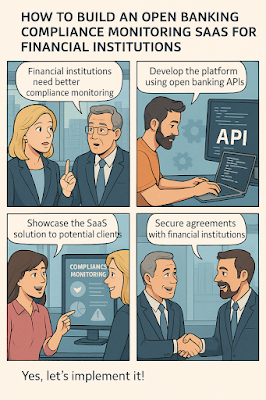How to Build an Open Banking Compliance Monitoring SaaS for Financial Institutions
How to Build an Open Banking Compliance Monitoring SaaS for Financial Institutions
Open banking has fundamentally transformed the financial services landscape.
With growing regulatory pressure, financial institutions must proactively monitor and enforce compliance across open APIs, third-party providers, and customer data sharing practices.
Building an Open Banking Compliance Monitoring SaaS can be a game-changer in this evolving environment.
Table of Contents
- Understanding Open Banking Compliance
- Key Features of the SaaS Platform
- Technical Architecture and Design
- Regulatory Framework Integration
- Deployment and Go-to-Market Strategy
- Final Thoughts
Understanding Open Banking Compliance
Open banking compliance ensures that financial institutions properly manage data sharing, third-party access, security protocols, and customer consent processes.
Major regulations like PSD2 in Europe, CDR in Australia, and the CFPB’s 1033 rule in the U.S. shape how open banking must operate.
Building a SaaS solution requires aligning closely with these frameworks from day one.
Key Features of the SaaS Platform
A powerful Open Banking Compliance Monitoring SaaS should offer the following capabilities:
API Activity Monitoring: Track and log all API interactions with real-time alerts on anomalous behavior.
Consent Management: Verify and audit customer consent across all connected third parties.
Data Governance Controls: Monitor how customer data is accessed, used, and shared.
Regulatory Reporting: Generate automated compliance reports aligned to local and international standards.
Security Audits: Conduct routine security posture assessments on open banking integrations.
Technical Architecture and Design
Your platform's architecture should prioritize scalability, security, and modularity.
Consider using a microservices-based design to separate consent verification, API monitoring, and regulatory reporting into distinct components.
Leverage AWS, Azure, or GCP for cloud-native deployment with Kubernetes orchestration for flexibility and reliability.
Example Architecture Components:
Frontend: ReactJS dashboard with real-time compliance status updates.
Backend: Node.js or Python microservices communicating via RESTful APIs or gRPC.
Database: Use PostgreSQL for transactional data and Elasticsearch for fast compliance searches.
Security: OAuth 2.0, OpenID Connect, and advanced API Gateway protections.
Regulatory Framework Integration
Staying compliant requires your platform to align with multiple frameworks simultaneously.
Key elements to integrate include:
Strong Customer Authentication (SCA): Especially critical under PSD2 regulations.
Data Portability Rights: Facilitate user-controlled data sharing in line with GDPR and CCPA requirements.
Real-Time Fraud Detection: Required under several open banking standards worldwide.
Partnering with regulatory experts can drastically reduce time-to-market for your SaaS compliance modules.
Deployment and Go-to-Market Strategy
When launching your Open Banking Compliance Monitoring SaaS, a strategic approach is critical.
Target financial institutions, fintech startups, and credit unions that need robust compliance capabilities.
Offer modular pricing plans: a freemium model for startups, a full-suite enterprise version for banks.
Effective GTM Channels:
Regulatory Conferences: Showcase your solution at finance and regtech summits.
Partnerships: Partner with open banking API providers like Plaid or TrueLayer to co-market your tool.
Content Marketing: Create educational resources highlighting evolving open banking regulations and your SaaS solutions for them.
Final Thoughts
Building a SaaS for open banking compliance is both a technical and regulatory challenge—but also a huge opportunity.
By ensuring real-time visibility, consent control, data governance, and regulatory reporting, your platform can become a vital piece of any institution’s open banking strategy.
With the right design and market approach, your SaaS can not only ensure compliance but also deliver significant business value to your customers.
Important Keywords: Open Banking Compliance, Compliance Monitoring SaaS, Financial Institutions, Regulatory Reporting, Consent Management
